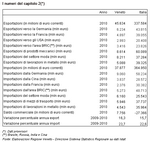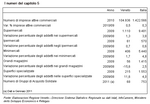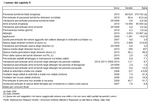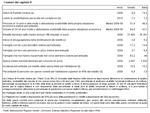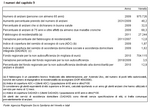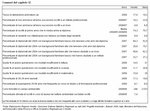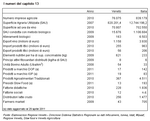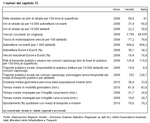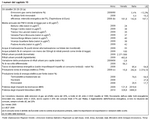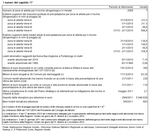-
Statistical department’s site
Home page
Our publications
The figures tell the story
Economic recovery by rationalising resources
Figures for 2010 confirm the recovery is underway: Gross World Product (GWP) rose by 5% due to a +12.4% spurt in international trade. Emerging and developing countries are also driving the world recovery as they recorded growth of 7.3% in 2010. A recovery in industrial production in 2010 caused a surge in the prices of raw materials. The increase in the prices of food raw materials, which started in summer 2010, extended over the next few months; industrial commodity prices rose on the back of soaring oil prices. The European Union closed the year with 1.8% growth, as did the Euro Area, proof that a recovery was underway. In Italy, GDP rose by 1.3% in 2010. However, despite growth in private consumption and investments, levels were still well below pre-crisis ones due to the 2009 slump.Official figures from the regional government's accounts department stop at 2009, the year that measures the impact of the international recession. Against this backdrop, Veneto's economy slowed in line with those of the other heavily industrialised regions; in 2009, Veneto's GDP narrowed by 5.9%. Forecasts for 2010 by the Prometeia research institute state that Veneto's economy will grow by 1.6%, more than the national average of 1.3%, and is likely to grow by 1.3% in 2011. The 2010 estimate is due to a relaunch of industry in the narrow sense, the value added of which is thought to have grown by 4 percentage points, and to a 1.2 percentage point recovery in both the tertiary and agriculture sectors. The construction industry, however, is still frail, down 0.9%.
The crisis caused a brusque deterioration in the public finances in all developed economies: in EU27 countries net borrowing, which was 0.9% of GDP in 2007, soared to 6.8% in 2009; it was 6.4% of GDP in 2010 and is estimated to be 6.5% in 2011.
Public debt, which was 59% of EU27 GDP in 2007, reached 74.4% of GDP in 2009, 80% in 2010, and is estimated to be 83.8% in 2011.
In Italy public debt touched 119% of GDP in 2010, but net borrowing-to-GDP improved, settling at 4.6%.
Alongside the measures Italy has taken to consolidate its public finances, a further improvement is expected with the introduction of fiscal federalism. On the eve of the reform envisaged by Proxy Law LD 42/2009, which will introduce fiscal federalism, in Veneto the State spends 3,139 euro per inhabitant compared to an average of 3,900 euro in the regions with ordinary statute and 5,399 euro in regions with special statute. If we look at tax revenue, taking 100 as the average of tax transfers to regions with ordinary statute, each Veneto citizen receives an average of 68.
The development of international trade
In 2010 significant increases were recorded both in national exports (+15.7%) and in imports (+22.6%). The negative Italian balance of trade, about 27 billion euro, was due in large part to the deficit in the energy sector (-51 billion euro). This excluded, the national trade balance had a significant surplus (24 billion euro), even though in decline compared to 2009 (+38.2 billion euro).In 2010 Veneto consolidated second place in the regional rankings for the total value of exports (45.6 billion euro and a 13.5% share of the national total). After a decline of 21.5% in 2009, Veneto's export performance (+16.3% compared to 2009) was better than the national one (+15.7 percent) . The trend in the flow of trade in recent quarters highlights a significant and stable growth in regional exports, but it only partially recovered from the massive decrease of regional foreign sales caused by the international trade crisis in 2009. In the first quarter of 2010 regional exports recorded a small increase (compared to the same quarter of the previous year), equal to 2.4%, which went on to exceed 20% in the last three quarters of 2010.
The analysis of the trend in exports towards various markets highlights how the increase of exports from Veneto involved primarily flows towards countries outside the EU (+20% compared to 2009 and a regional share of 40%), with particularly significant variations to the United States (+30.9%), China (+49.8%), Russia (+18.6%), Hong Kong (+34.0%), Switzerland (+25.9%) and Turkey (+24.4%).
In 2010 an increase in exports was recorded in almost all sectors of economic activity. The leading sector in Veneto's exports remained the mechanical industry (18.9% of regional exports), followed closely by fashion (18%).
In 2010 the value of imports to Veneto was about 38 billion euro (10.4% of the national total), an increase of about 24% compared to 2009. The most imported products were those of the fashion sector (16.3% of the regional total and an annual increase of +17.5%), vehicles (15.7% of regional imports), food products (12.9%) and metals (12%).
The EU continues to be the principal source of imports to Veneto, with a share around 64% of the total (Germany remains the principal partner, with about 24% of regional imports). The second source is East Asia with 14.1%.
Business in the age of the Green Economy
Production in Veneto has embarked on the long road to recovery that will take it back to the situation it was in before the crisis. In Veneto in 2010 the number of active enterprises stayed more or less the same, -0.2% compared to the previous year. If we exclude the primary sector, then the variation of active enterprises from 2009 to 2010 was positive at +0.3%. The two sectors which shrank the most in 2009 due to the problems with the market-agriculture and industry-were not able to make up for lost ground in 2010 either: the primary sector lost 2.8% of its active enterprises in the last year, the manufacturing industry lost 1.5% and construction 0.9%. At the same time, the services sector proved particularly healthy. Enterprises in this sector grew by 1.3% in 2010, continuing towards consolidating the position of services in Veneto; in 2010 these enterprises made up 53.3% of production activities.In Veneto there were 406,011 small and medium-sized enterprises in 2008, excluding the agricultural sector, making up 99.8% of the whole business system. Large firms, despite the fact there are no more than 800 of them, nevertheless constitute 18.7% of private employment in Veneto. More than 92% of SMEs have fewer than 10 employees and less than 2 million euro in turnover per year, putting them into the category of micro-enterprises. Micro-enterprises provide employment for 42.4% of all workers in Veneto.
There are 26,793 small enterprises in Veneto, 6.6% of the SMEs; half of these have a turnover of less than 2 million euro a year but they do have more than 10 employees. A total of 23.5% of employed persons in Veneto work for a small enterprise.
Medium-sized enterprises count for just 1% of production businesses, with a share of 15.3% of total Veneto employees. More than 1,000 of the 4,224 medium-sized enterprises in Veneto do not have a turnover of over 10 million euro per year, although they do have up to 250 employees.
Enterprises which contribute towards eco-friendliness guarantee their own survival and development in the long-term and can take advantage of eco-efficiency to increase their competitiveness. For this reason, enterprises are becoming increasingly aware of the importance of environmental certifications. In December 2010 there were 82 sites and 60 organisations with EMAS certifications in Veneto; in the same year 12,371 production sites in Italy and 1,032 in Veneto were certified under the ISO 14001 standard.
The role of research and development and innovation
EU27 expenditure on R&D was equal to 2% of its GDP in 2009, a slight increase on the previous year. In 2009 R&D expenditure in Italy was 1.27% of GDP, while for Veneto it was 1.05% in 2008, lower than the national figure, but the figure had almost doubled in 3 years.In 2008 Veneto's expenditure on Research and Development amounted to 1,542 million euro, a 24.1% increase with respect to the previous year and compared to national growth of 5.9%. This trend was fuelled by the widespread investment of enterprises, which increased by 36.4% in the last year. In 2008, 64.6% of total expenditure on R&D came from Veneto enterprises, followed by universities, which contributed 25.1%, and public and private non-profit institutions the remaining 10.2%.
Veneto has a total of 23,884 R&D workers and in relation to the population this makes 4.9 for every 1,000 inhabitants compared to a national value of 4.0.
A total of 87.3% of all business expenditure in Veneto, which comes to almost 1 billion euro, stems from enterprises with registered offices in the region, and 12.7% from enterprises registered outside it, but which carry out research at production units in Veneto.
A total of 26.7% of R&D expenditure in this sector comes from the mechanical sector, followed by textiles, clothes, leather and accessories, optics and electronics, chemicals-rubber-plastics, and metals, with expenditures which range from 11.1% to nearly 15%.
There are also traditional Veneto activities, such as the jewellery, wood and furniture, sports items and food industries. In 2008 enterprises with registered offices in Veneto invested 910 million euro in R&D, almost 870 million of which in the region. A total of 51.1% of investments come from companies with a turnover of over 50 million euro, 25.5% from companies with turnover of between 10 and 50 million euro, and 10.4% from those with turnovers of between 5 and 10 million euro.
With 6,348 patent applications in 2010, Veneto has 9.1% of the national total and ranks fifth among all of Italy's regions for patent applications. A total of 1,292 patent applications were made per one million inhabitants in 2010, (1,155 in Italy), and 13.9 patents every 1,000 businesses (13.2 in Italy).
Public Administrations are also involved in the drive towards technological innovation: in Veneto 97.5% have an institutional website which provides information and manages some services online, such as payment of council property tax and waste-collection bills. Yet in Veneto only 28% of Internet users say they have searched online for information from Public Administration websites (29% in Italy). The use of ICT by enterprises is, however, higher.
The market in the hands of responsible consumers
Trade stands in first place out of the production sectors in the tertiary sector in Veneto: in 2010 active trade enterprises made up 43.1% of service enterprises and 23% of all Veneto production businesses. Value added at base prices in the trade sector in Veneto in 2008 represents over 11% of overall value added produced in Veneto, and the sector employs over 14% of the region's total workers. Trade in Veneto closed 2010 with a positive variation in the number of active enterprises, +0.5% on the previous year, showing more stability therefore than the Veneto economy as a whole. In 2010 Padova was still the province with the highest share of trade enterprises (22.1% of the regional total). The index of retail sales also picked up slightly on a national scale in 2010 after the 2009 decline.
There are an average of 10 large-scale organised distribution establishments in Veneto per 100 km2, with many differences to be found within the region: the province of Padova has the most large-scale distribution retail outlets, with 17 per 100 km2, followed by the provinces of Vicenza, Treviso and Verona with more than 11 establishments per 100 km2. If we look closely at the evolution of the types of distribution under consideration, we can see that hypermarkets are settling in Veneto and growing steadily (+7% from 2008 to 2009); their popularity is based on their convenience. Supermarkets, which have been around for a good while now, showed more moderate growth (+1.5% per year). Department stores and minimarkets on the other hand, after some years of expansion and market stability, have recently hit a sharp downturn (-27.3% and -3.1% per year respectively in 2009). The large specialist stores have proved to be the most dynamic as the number of establishments, sales surface area and number of employees have continued to expand since the beginning of the 21st century and have increased by 9.7%, 12.5% and 11.6% respectively in the last year.
Sustainable tourism
For years Veneto has been the leading tourist region in Italy with 14.6% of arrivals and 16.3% of nights spent in the entire country in 2009. In 2010 the number of tourists visiting the region was once again on the rise, a positive sign after the halt in development in the sector following the economic crisis which began at the end of 2008, one that affected the demand for tourist services at a European level. In the meantime the trends of tourists have changed: they prefer closer destinations, briefer holidays, saving on expenses once they arrive at their destination. In 2010 there were over 14.5 million tourists, up 600,000 on the previous year (+4.6%). The recovery corresponds to a smaller increase in the number of nights spent (+0.6%), reaching over 60.8 million, revealing a reduction in the average number of nights spent in holiday destinations (4.2 days).
Tourism in Veneto is based mainly on a flow of international visitors (60.4%). Their number of nights spent increased by 2.3%, which compensates for the decrease in nights spent by Italian visitors (-1.8%). In both cases the number of arrivals has risen: +0.8% for Italians and +7.1% for international visitors.
In 2010 Veneto came second in the national ranking for revenue from international visitors. Such a noteworthy result is reached not so much because of their length of stay (on average just over 4 days), but because of their considerable numbers, 19.7% of the national total. The income from international visitors has a considerably higher effect on the region's economy than at national level (2.8% of GDP compared to 1.6%).
Spending on culture by Italian families was well below the EU27 average, amounting to only 6.9% of total spending in 2007, while the European average was at 9.4%. Compared to the rest of Italy, Veneto ranks third, with a share of 7.8% of total spending.
Listening to the population to keep up with change
The size and nature of the population have a long-term impact on the sustainability of development. It is clear that the population of many European countries, and Italy in particular, is destined to age. There are five long-term EU strategic priorities that intend to transform the challenge of ageing into an opportunity for growth: favouring demographic renewal, promoting employment, making Europe more productive and dynamic, welcoming and integrating migrants, and assuring sustainable public finances. Some important social and economic consequences of ageing require attention. According to EU policy, structural reform of the social security system is required for financial sustainability, at the same time as assuring pensioners a satisfactory standard of living in the spirit of intergenerational solidarity.In a country where the young population is declining, migration, both in terms of entries from abroad and new births, is important in re-establishing a demographic balance. Immigration to Veneto is above the national level and the concentration of many different ethnic groups makes integration even more challenging: the aim is to live together without conflict between cultures, religions and lifestyles, facilitating foreigners in the creation of their own space in society, the labour market and education. Much remains to be done in terms of socio-economic integration. Currently foreigners' working situations are not always favourable and they are thus even more seriously affected by the economic crisis.
Alongside voluntary migration there is also forced migration, people who have been forced to leave their home countries due to persecution, ethnic rivalries or conflicts. Among these are many minors, who often arrive in Italy alone, without family members. Unaccompanied minors are the new protagonists of migratory flows; their number has drastically increased and they make up a considerable part of the asylum-seeker population. Recently Italy has been called upon to manage the 'emergency immigration' of citizens from North African countries who, together with others from the Arab world, are escaping from a difficult political and social situation.
Wondering about the destiny of our population has aroused curiosity about our roots. Through data from censuses from 1871 to today, we can find great administrative and territorial, as well as demographic and socio-economic changes. Together with growth in the population and in the number of families, there have been changes in the types of family, in terms of composition and age. Achievements in education have proved decisive, not only for economic development but also for improving quality of life. Since the Unification of Italy, Veneto has been transformed from a population of illiterate people and farmers to a region which is reaching out to Europe in economic and cultural terms.
The families of today and tomorrow: a question of balance
The challenge of sustainable development is the lasting maintenance or improvement of quality of life without compromising future generations, who should be guaranteed the same opportunities that we have had and the freedom to choose how to build their own lives and futures. The concept of development, moreover, cannot be measured in terms of economic growth alone. Factors directly representing quality of life and characterising the level of satisfaction for people's fundamental needs, of a physical, cultural and spiritual nature, are becoming increasingly significant. People are less satisfied with the quality of their work, amount of free time and their financial situation: people aged 25 to 34, who have found it difficult to achieve financial independence, have been particularly hard hit. On the other hand, they are satisfied with relationships, friends and family, and with their health. Wealth and financial resources contribute to the progress of a society, but this development is sustainable only if it guarantees equally distributed growth throughout the population. In Veneto income inequality seems more contained than elsewhere and, compared to other regions, families have financial resources that allow them to lead a good quality of life and to withstand the effects of the recent economic crisis. This is also thanks to the high number of multiple incomes.
Being able to count on a stable income which is sufficient for the size of the family and its desired lifestyle gives a sense of security and passes the desire to make plans on to future generations. Not all families, however, can afford an adequate standard of living and the problems that they face change over the years, something which also depends on how the family evolves. Single-parent families and elderly people living alone have the biggest financial problems, while there are oscillating trends for single people and young couples, probably because they have not yet reached financial stability and are influenced by the trends in the employment market. Having children brings increased financial hardship, especially if there are more than two, while mature couples with grown-up children who no longer live at home have greatest financial stability.
One of the medium-long-term strategies to guarantee a family's financial security is saving, which, along with more careful spending, can be vital in case of emergencies or unexpected situations. Nowadays, however, saving is not that easy and many have the impression that they have less money. Due to the economic crisis, it has become necessary to prioritise when budget-making, taking into account the limits set by certain essential expenses. The main expense is the home, which takes up a considerable share of the family's expenditure.
Services for elderly dependent people
The ageing of the population is drawing attention to the issue of the sustainability of public expenditure on social and health care and of policies for the elderly who are non self-sufficient. In general, the health conditions of the elderly are good and improving, however there is an association between old age and the onset of degenerative illnesses or disabilities, especially with the very elderly. While on average life expectancy is increasing, it is also true that in the final stages of life an elderly person will no longer be self-sufficient. In fact the period between the onset of reliance on care and death will in time become longer. When health conditions limit an elderly person's independence, currently it is usually the person's children who take care of him or her, filling the gap in the State's welfare system. But although in the past the elderly could count on their numerous children and the non-working women in the household, many of the elderly people of tomorrow will be without an extended family network, in particular in the case of families that have broken up. The future of health expenditure therefore not only depends on the ageing population, but also on the incidence of elderly people with disabilities and on an imbalance between formal and informal treatment, not to mention the type of services that the healthcare system intends to provide: residential care, semi-residential care, and home care.
Veneto's care network for elderly dependent people is the result of policies which, over the years, have led to a range of measures geared towards a complex social and healthcare situation. The importance of keeping elderly dependent people in their own home and social environment is receiving increasing recognition. Therefore for some years, regional policies have aimed to enable people to stay at home, while residential care is only used for people who have no other option. Home care and family support services are planned, including social home care and integrated social and health care, financial support, such as care allowances, and respite services for families, such as temporary stays in residential care and holidays for those who are reliant on care.
In 2010 the Regional fund for non self-sufficiency amounted to more than 704 million euro, an increase on the previous year. Even though most of the resources are allocated to residential care, regional policy has been to increase the funding of home care in recent years.
Protecting ourselves from fear
Human beings have always had a basic need to protect themselves from fear: fear of being a victim of physical and psychological violence, fear of accidents at home and at work, fear of disasters, of terrorism, of war, fear of the future, and of being unable to afford an independent and dignified standard living for oneself and one's loved ones. Fear of being a victim of crime is one aspect of people's lives that is taking on greater importance in the complex set of factors that make up the quality of life of a community. It is a variable that plays a significant role in guaranteeing the sustainability of developmental processes.A first objective measure of the crime level comes from number of crimes reported. In the period between 2005 and 2009, for Veneto the crime rate for every 100,000 inhabitants remained constantly below the national average and recorded an overall fall. More than 70% of the reports concerned crimes against property, especially thefts, in only 10% of the cases were crimes against the person. The latter, both in Veneto and Italy, increased generally in the period studied. Thefts in homes, from retailers, and pick-pocketing increased, while motor car theft declined.
In addition to the crime rate, it is important to know how many victims there are and to be able to profile them based on their personal, family and social characteristics, plus any other factors of risk, in order to better manage the target community safety policy. In this regard, it is particularly serious that a significant part of the crimes was concentrated on a relatively small number of victims; in fact there is a part of the population that is particularly fragile and seems to be exposed to the risk of being a repeat victim of the same crime or a variety of crimes.
Exploring crime means studying how people perceive it, whether they consider it a serious problem or not, and if so, the degree to which they feel threatened. The fear of being a victim of crime has a negative impact on the quality of life, limiting personal freedom to the point that people change their everyday behaviour and habits. On whatever level the phenomenon is examined, whether it be individual fear or as a collective social problem, the concern is obviously higher among its victims as they have directly experienced the consequences of crime.
The figures tell the story
The deadline for the Lisbon Strategy, which was launched in 2000, and the introduction of the new Europe 2020 Stategy coincided with an economic crisis that adversely affected the labour markets of virtually all European economies. Much of the progress made in employment until 2008 was reversed.In 2010 Italy's employment rates continued to fall and the number of job seekers increased; Italy's employment rate was 56.9%, 13 percentage points from the Europen target. The situation in Veneto is better, as it stands fifth in the regional rankings for employment rates with 64.5%, and an unemployment rate of 5.8% which despite being the highest of the last decade, is still one of the lowest in Italy; what is more important is that unlike in other regions, Veneto's unemployed are actively seeking work, while its number of inactive working-age population and its demoralised workers are falling.
In order to leave the crisis behind and boost economic prosperity, equal employment opportunities need to be given to everyone; an increase in the labour-market participation of women, young people and migrants thus plays a key role.
Although Veneto is still some way adrift of the 60% Lisbon Strategy target for women's employment, the situation is nevertheless better than at national level: 53.3% compared to 46.1%. Veneto's employment rate among 55-to-65-year-olds is also good as in ten years it has increased by 10 percentage points. Young people, however, are still finding the labour market problematic, and there are still gaps between foreigners and Italians as regards unemployment rates and contractual conditions.
However it is not only the major economic and financial crisis that has hit the world economy as alarming climate changes and natural catastrophes have led to an overhaul of economic policy to make it more sustainable and greener in a quest to combine safeguarding the environment with economic and social development; this strategy may be one way of fending off the economic and financial crisis.
It is estimated that in 2009 Veneto had 109,000 green employees (excluding the primary sector) up more than 8% on 2005 and accounting for more than 5% of total employed persons. The highest proportion of green jobs is in Belluno, followed by Padova, which experienced the highest growth since 2005.
The key role played by schools in social sustainability
The relaunching of the European Strategy was an opportunity to emphasise the fundamental role that education and training have to play and to improve their quality in order to assure greater benefits and opportunities for young people. The following aims are therefore considered priorities: combating school dropouts, which must fall to 10% by 2020, and raising the share of 30-to-34-year-old graduates to at least 40%. In 2009 in Italy 19.2% of young people aged 18-to-24 had a qualification lower than a secondary school diploma and were not attending other school courses or training courses, while in 2000 it was 25.1%; the figure is, however, still far from the EU27 average of 14.4%. The 17% dropout rate in Veneto is better than the national average, but the percentage of young graduates is still low however, just 17.3% of 30-to-34-year-olds compared with the EU27 average of 32.3%.One of the European strategic objectives is to improve basic competences in reading, maths and science, and to bring the number of pupils with dissatisfactory results in these subjects down to 15% by 2020. The results in Veneto are satisfactory and already in 2009 the objectives were reached for reading (14.5% of 15-year-olds in Veneto had dissatisfactory results) and science (11.7%); maths was not far from the target (15.9%). Italy, however, is still far from these levels with over 20% in all of the three subject areas.
Family status still has considerable influence on choice of school, results and prospects after leaving school. The higher the parents' educational attainment and professional position, the lower the percentage of young people who choose a vocational or technical school and the greater the preference for lyceums. In Veneto, 33% of young people from families with lower-level profiles choose vocational schools and only 14% choose lyceums. Viceversa, 60% of those with higher-profile families select lyceums. Furthermore, regardless of the type of school attended, 64% of young people with low-profile families go to work after leaving school, while those from better-off families go to university.
On the whole, educational attainment in Veneto is higher than the national average: 74.3% of those enrolled in the first-year of high school obtain their school-leaving diplomas compared to 71% for Italy, but things change according to the type of school chosen. Those who go to lyceums obtain better results, while those attending vocational schools struggle more.
Finally, lifelong learning, which is supposed to reach 15% by 2020, is also fundamental but it is still around 6% in Veneto and Italy; training in the environmental sector, the new bastion of the modern economy, is also important. Veneto accounts for 12.1% of the nation's environmental courses, the second highest region after Toscana with 14.7%.
Fields hold the answers to the latest challenges
In 2010, there were just over 76,000 agricultural holdings enrolled in the business registers of Veneto's Chambers of Commerce, a 2.8% fall on 2009. It was a continuation of the trend of the last few decades, although the amount of farming land has remained much the same. A total of 33% of Veneto's UAA is covered by corn, the most extensively planted crop. Forage crops also account for a high percentage, and both of these crops provide fodder for Veneto's animal husbandry industry. Veneto has more than 70,000 hectares of wine-growing UAA, up slightly on 2009.
Organic farming is becoming increasingly common throughout Europe and figures for 2009, the latest, show that Veneto has 15,000 hectares, managed by 1,000 producers. Veneto has 163 organic farms registered with inspection boards; many of these are bee farmers and around 50 are cattle breeders.
Despite the economic crisis of recent years, the wine industry is the driving force behind the region's agriculture. Wine exports confirm Veneto as Italy's leading region for international sales, with a turnover of almost 1.2 billion euro in 2010.
In 2010, Veneto imported 254.9 million euro of fishing and aquaculture produce; its exports however reached 56.2 million euro, a negative trade balance of 198.7 million euro.
In 2009, Italy's use of agricultural fertilisers fell by almost 10% on the previous year. Phytosanitary products are following the same trend both in Veneto and in Italy. These figures suggest that EU programmes in support for eco-compatible and organic farming are on the increase.
Veneto is Italy's leading region for number of Protected Designation of Origin (DOP) and Protected Geographical Indication (IGP) products. In addition to the more well-known DOP and IGP marks, others have also been established to safeguard specific features and local tradition, but they are not linked to the production area; these include Traditional Foodstuffs and Agricultural Products (PAT) and Slow Food Presidia.
There is also an increasing propensity by Veneto's farming and foodstuff producers to create networks that are geared towards setting up multi-purpose holdings, as shown by its 228 educational farms, 12 social farms, 256 raw-milk distributors an
Sustainability and the mountains
Mountains cover 34% of Veneto, yet less than 10% of the regional population actually live in these areas. Based on territorial unity criteria that consider economic and social factors, the mountain territories are divided into homogenous areas that make up the Mountain Communities.The 19 Mountain Communities in Veneto include 171 municipalities that are made up entirely or partially of mountainous areas. The aim of creating these Communities was to re-establish the value and importance of these areas together with active participation on the part of local people.
The only constraints on forest management that have impacted current forestry practices regard the recognition that timber yields must always be inferior to the regeneration rate of the forests. This will maintain 'safety levels' that ensure forest species will survive and develop and that forests follow a natural path of renewal. In Veneto the mean standing volume of production forests is about 288 cubic metres per hectare and 110 cubic metres per hectare for coppice.
Sustainable forest management is the pivot around which all "forest-wood-energy" policies and initiatives revolve and it is supported by a significant number of forestry businesses. There are currently about 300 forestry businesses registered in the provincial registries of the Regional Forest Service.
To date the woodland surface in Veneto covers nearly 400,000 hectares, equal to 4.5% of all the forests in Italy. In spite of the fact that most of these areas in Veneto are used for arboriculture for timber, it is worth pointing out the importance that chestnut orchards play in the overall economy of the mountain areas. Even though they only make up 5% of the wooded surface area, they play a fundamental role in the food sector, the energy sector, and in the production of manufactured goods for the agricultural sector, such as casks and beams.
Travelling is good, sustainable travelling is better
Some basic information will enable us to provide an outline of Veneto citizens' styles and behaviour with regards mobility.Every year, from 2008 to 2010 the average number of daily journeys, the distance travelled and the time spent travelling have decreased. Most journeys are still carried out by car. Every day, in 2010, the average person travelled 36.4 km and spent 62 minutes travelling. In 78% of cases this journey took place in a motor vehicle. Workers take an average of 22 minutes to get from home to work and 85% take under 30 minutes; students take 19.5 minutes to get from home to school and 84% get there in less than 30 minutes.
In 2009 public transport overall carried 252 passengers per inhabitant in the capital municipalities, a figure slightly higher than the previous year.
In terms of demand for privately-owned vehicles, in 2009, the most recent year for which data are available, the vehicle stock dropped slightly (-0.3%) for the first time in years: there were just under 3.8 million vehicles, 77% of which were cars (+0.8%).
The unstoppable increase in the use of motorcycles continues however: in 2009, 86 out of every 1,000 inhabitants (4 more than in 2008) owned one, adding up to 420,000 motorcycles overall.
In Veneto in 2009, 35% of cars met the "Euro 4" and "Euro 5" standards on polluting emissions, 49% belonged to the "Euro 2" and "Euro 3" categories, and just 9% to the "Euro 0" category.
In 2009, 73.6% of 14-to-80-year-olds admitted to using their cars regularly (at least 3-4 times a week), and 87% of car users were satisfied with this means of transport.
A total of 40% of those interviewed stated that they would like to use more public transport in future, while 35% would like to cut down on their use of "four-wheeled" transport. "Accessibility/convenience" is cited in 80% of cases as one reason for not taking public transport: the service is either not easily accessible ("the stop is too far away", "the timetable doesn't tie in with my schedule") or it is inconvenient in other ways ("I would have to take more than one means of transport and I don't want to", "the change-over is not smooth", "I have to travel elsewhere during the day").
The environment and energy
In 2008, the European Commission approved a series of interventions aimed at reducing pollution and protecting the environment. A series of goals involving energy and environmental issues were identified and called "20-20-20". This plan involves: decreasing greenhouse gases by 20% compared to 1990 levels throughout the EU by 2020; increasing the use of renewable sources of energy which, by 2020, are to make up 20% of end-user consumption; and improving energy efficiency by reducing consumption throughout Europe by 20% (although this target is still under discussion). By observing the trends from 1990 to 2008, in the EU there has been an overall decrease of 13.3% in greenhouse gas emissions, whereas Italy is still not in line with the rest of Europe as its greenhouse gas emissions have hardly changed at all. However, trends in recent years (-5.5% from 2005 to 2008) offer some encouraging signs. In Veneto, the air quality improved in 2009 when compared to previous years. The ARPAV monitoring stations located in urban centres show that the annual average concentration of PM10 exceeds the legal limit of 40 µg/m3 in Padova alone. Bathing waters are monitored in 167 stations and in 2009, 86% of these locations proved to be suitable for bathing. Both qualitative and quantitative measurements are used to monitor the quality of drinking water. The concentration of nitrates measured in tap water in 2009 was consistently below the 50 mg/l limit established by law. The quantitative data regarding the level of water reserves are positive as well: between 1999 and 2009, the levels remained stable in 89 out of the 119 stations and even increased in 18 cases.
Another topic that is closely related to the environment is waste generation and disposal. In 2009, 2,371,588 tonnes of urban waste were generated in Veneto, with an overall decrease of 1.8% compared to 2008. Per capita waste generation decreased by 2.6% to about 483 kg/inhabitant per year, a figure which is among the lowest on a national level. In 2009, Veneto reached 56.3% of waste separation, allowing it to surpass the 50% target established by Law L. 296/2006 for the year 2009.
Finally, energy is the immense challenge that today's economy is facing. The second 20-20-20 target deals with energy production with renewable sources. The most recent data available refer to 2008 and show that while the average on a European level is 10.3%, the average in Italy lags behind at 6.8%. The development of renewable energy sources is also aimed at reducing Italy's significant energy dependence on countries that provide fossil fuels. The rate of energy dependence on a European level is more than 50% and in Italy it reached 85.4% in 2008.
Another indicator of energy efficiency is the energy intensity of GDP, which is 142.6 toe/million euro in Italy, a figure that is better than the EU average of 167.1. On a regional level, making reference to 2005 as the last year with available data, the energy intensity in Veneto is 161.6 toe/million euro, a figure which is higher than the Italian average, but in line with the largest regions in the centre and north of the country.
Electric energy production in Italy decreased in 2009, partly due to the economic crisis. Thermoelectric energy continues to be the most commonly used source of energy; in 2008 it made up 79.5% of the total compared to an average of 54.5% on a European level. In Veneto, the types of alternative energy sources that have been developed the most are biomass plants and photovoltaic solar panels. In 2009, there were 46 biomass plants generating 121.9 MW. Significant growth in the photovoltaic sector in recent years has led to a situation in which these plants, as of 2010, generate 329.6 MW in Veneto, an increase of 321% in just one year.
31 October - 2 November 2010: The All Saints flood
During the flood which hit Veneto between 31 October and 2 November 2010, extremely large amounts of local rainfall were recorded. Peak rainfall, which occurred on the first two days, was to be found in the Upper Piave basin, one of the 7 areas of high hydrogeological risk, known as Vene-A. A total of 255.6 mm of rain fell on 31 October and 241.8 mm on 1 November. On 2 November the highest amount of rainfall, 98.6 mm, was recorded in the Vene-B area, in the Upper Brenta-Bacchiglione basin. All of the peak figures for average areal rainfall values, which were extremely high during the first two days of the flood, were to be found in the Vene-B area of high hydrogeological risk. The 138.8 mm of rainfall recorded on 31 October, the 149.5 mm measured on 1 November and the 50.6 mm which fell on 2 November are all practically twice the amount recorded in other areas. These figures explain why the upper and lower basins of the River Brenta-Bacchiglione ended up in such critical situations. The highest rainfall figures recorded during the three days were the maximum peak of 586.6 mm, which fell in the Vene-A area, and the 338.9 mm average which fell in the Vene-B area.The high concentration and amount of rainfall caused landslides, breaches of riverbanks and floods, and in many cases the water levels in the rivers hit record highs. Data from the Padova Civil Engineering Unit show that the water levels in the River Bacchiglione beat previous records in four out of five places. In Pontelongo, at 9 am on 5 November, the level reached 7.15 metres, a good 1.21 metres over the previous high measured in November 1966, though in 2010 two breaches of the riverbanks occurred upstream, displacing part of the high water. All of this caused a major impact, which is still in the final phases of being dealt with now, in May 2011.
The Civil Protection Department's prompt reaction and the solidarity of the people who provided help from the start enabled the situation to be brought under control as soon as possible. Furthermore, a special mention must be made of the generosity of the citizens, companies and associations from all over Italy who, by 29 April 2011, had collected 5,048,826 euro and also 893 movable goods such as electrical appliances, furniture, tools, toiletries and heaters.


